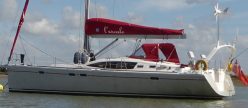Sunday 15 – Monday 16 September
Having completely missed the second National Park, the Islas Cortegada in the Northeast corner of the Ria de Arousa, we motored among the dolphins and through the viveros to Vilanova, where the very helpful harbour master allowed us to fill up our water tanks free of charge. Meanwhile, Mate prepared lunch to eat underway, and we were soon enjoying sailing at 6+ knots under full main and genoa. As we continued Southwest, the wind died to nothing and by 1900 we were comfortably settled at anchor in the lee of Isla Ons, the third National Park. Well-researched as ever, Skipper had previously applied for and obtained permits both to sail in these restricted waters, and to anchor here overnight.

Facing the Atlantic – The Burato do Inferno
Bright and early on Monday morning, picnics were prepared and walking boots donned to explore this stunning island. It was warm and sunny, and until the trip boats brought the first tourists four kilometres from the mainland late morning, we had the place to ourselves. The tracks are well-marked and follow the perimeter of the island, through a surprising variety of scenery for an area only about three miles long and half a mile wide, a total area of 414 hectares. The Atlantic National Parks represent the peaks of what was a mountain range consisting of schist, granite and gneiss. The lighthouse stands at the highest point, 128 metres above sea level.
The East coast, looking towards the Ria de Pontevedra, is lower-lying with a series of beaches. There is a small semi-permanent community near the ferry landing, and a campsite well hidden in the trees. Every building carried a banner declaring “World Heritage Site – No; Island Rights – Yes”. Facing the Atlantic Ocean, the West coast is rugged with vertical cliffs, jagged rocks and sea caves, known as furnas. Of these, the roof of the ‘Burato do Inferno’ has long since fallen in, and is said to echo the cries of the dead who remain trapped between Heaven and Hell.
The island has a plateau-like relief, with several flat peaks that form scrubby moorland of heather, gorse, blackthorn, ferns and an endemic Retama broom, Cytisus insularis, that is unique to this and Salvora island, that lies just Northwest. On the more sheltered East coast are small stands of bay (laurel), Pyrenean oak, willow and elder (alder) trees, as well as some eucalyptus and pine, deliciously fragrant in the warm sunshine.
Flora must be able to survive the harsh environment of salt wind and dry sunshine, and these include European beachgrass, Portuguese crowberry, field pennycress, mallow bindweed, sand couch-grass, Linaria arenaria and curry plant, also wafting on the breeze. Also present are sea fennel, Calendula suffruticosa (subespecies algarbiensis), sea thrift and garden angelica, where the cormorants build their nests.
The tidal waters around the island contain sea urchins and anemones, a wide variety of shellfish, including winkles and crabs, and the local delicacies of goose barnacles and octopus. On sandy bottoms are found razor clams, cuttlefish and hermit crabs. The abundance of marine organisms make the island a perfect nesting site and transit point for many species of birds. It hosts the largest concentration of yellow-legged gulls and common shags in the world, whose neighbours include Caspian gulls, the red-billed chough and Alpine swift. There are smaller numbers of common guillemot, lesser black-backed gull and European storm petrel.
Seasonal visitors include great cormorants and Northern gannets in Winter, Sandwich terns and Balearic shearwaters in Summer. On the coastal fringes, plovers, common sandpipers, herons, egrets, turnstones, curlews and other waders are common. Nesting among the trees are colonies of birds of prey: northern goshawk, common buzzard, common kestrel, European nightjar, and peregrine falcon; and small birds: tits, warblers, blackbirds, woodpigeons, finches, turtledoves and greenfinches.
Nailed to treetrunks in one area are a number of bat boxes, offering prime real estate to the common pipistrelle, serotine bat and greater horseshoe bat. We saw evidence: scrapes, scat and corpse, of wild rabbit, and other small mammals recorded here include hedgehog, shrew, mole, house and wood mouse, brown and black rat, and otter. Creatures introduced by humans and posing a real threat to native species include wildcat and American mink.
Being a warm, soft summer’s day, many butterflies flitted around us; the guide notes Old World swallowtail and Harlequin species, of which I think we saw the latter, as well as small and large white and something akin to Meadow Brown. We also Orthoptera – grasshoppers and crickets, among the insect species recorded. Along the tracks were information boards, where we saw (thankfully the only) examples of ladder snake, southern smooth snake and viperine water snake, but we did spot an ocellated lizard, the largest European lizard, and many Iberian wall lizards.

In the waters around the island have been spotted short-beaked and bottlenose common dolphin, sperm and fin whales, loggerhead and leatherback sea turtles.
A well-earned beer slaked the thirst before we paddled back home and made our way into the Ria de Pontevedra, where we tucked behind a headland between Puerto Novo and Sanxenxo marinas for a quiet night in spite of the built-up nature of this area, very popular with Spanish holidaymakers in the season.
